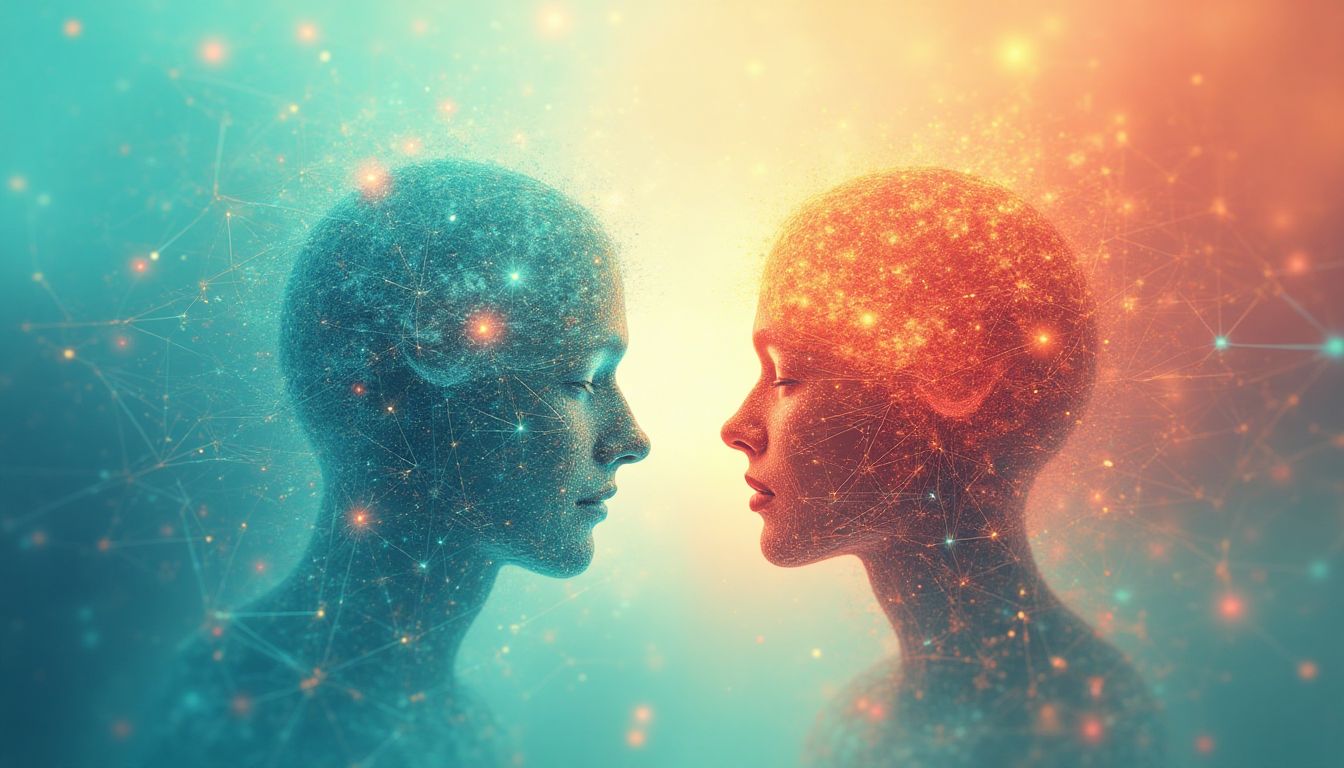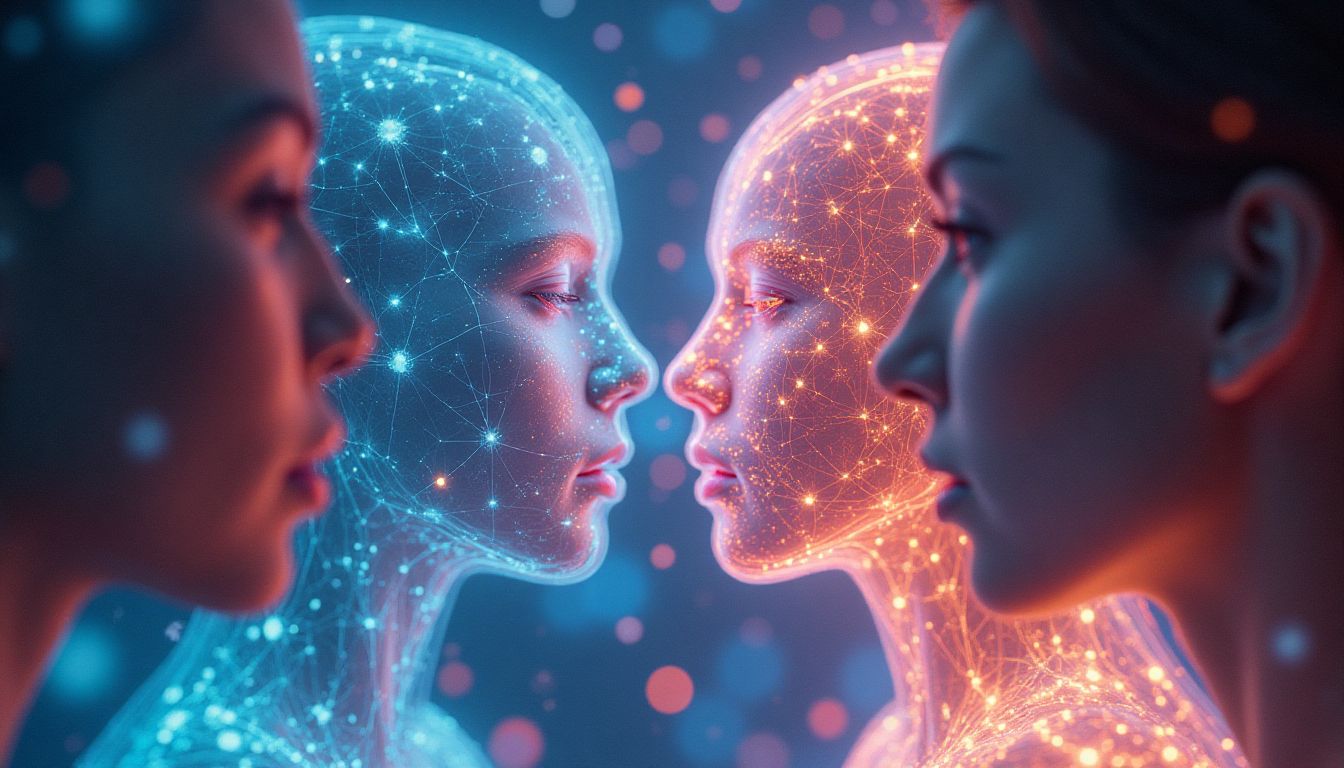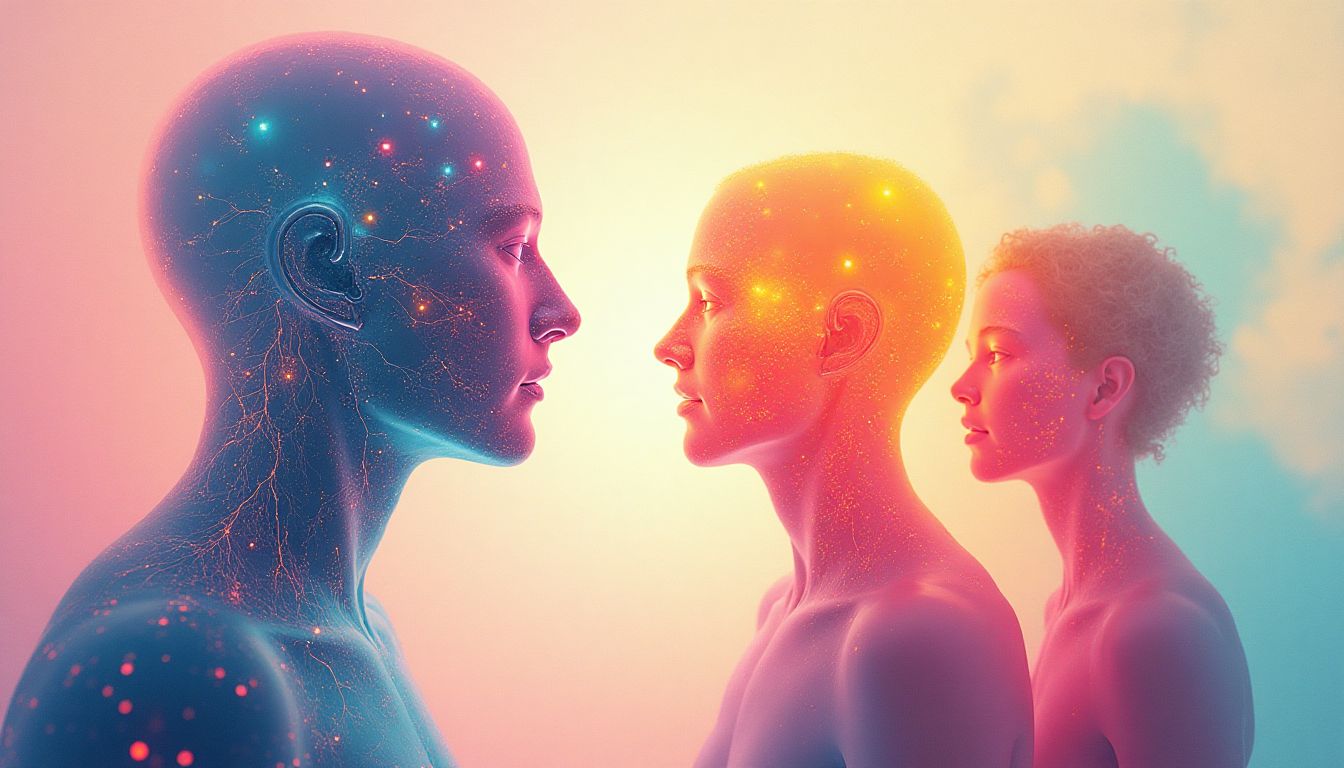Introduction: The Omni-Empath - Exploring ASI's Emotional Connectivity
"The soul never thinks without a picture," observed Aristotle, and today, the very essence of artificial intelligence is being painted with the colors of human emotion. Imagine a world where Artificial Superintelligence (ASI) not only computes but feels; an ASI that resonates with the passions, joys, and challenges of every living being. Welcome to the era of the Omni-Empath.
Now, let's talk numbers. A study by AI Impact Institute concluded that by 2030, empathetic AIs could potentially enhance user interaction experiences by over 85%. That’s not just a leap; it's a giant transformation in human-computer interaction. But what does this really mean for us, the sentient beings of Earth?
Picture an ASI that can laugh at your jokes, nod in understanding, and perceive the subtleties of emotions just by the slight rise in your voice. It's like having a best friend who's also a super-genius. Michio Kaku, an acclaimed physicist, speaks of machines almost dreaming in technicolor—a reality within grasp due to the empathic wave sweeping through AI innovations.
Now, why the fuss about Omni-Empath? A concept that has its roots in merging subjectivity with data-driven insights. As coined by Ray Kurzweil, the term describes AI that grasps not just data, but the emotional undertone of that data. The drive is not just to know but to connect.
This shift is more than just an algorithmic upgrade; it's a philosophical rethinking. What's the limit when ASI can share compassion or soothe a sorrow? Stephen Hawking, known for his brilliance, warned us about AI’s double-edged sword. With empathy, we ensure it's not just a cold blade but a helping hand.
**Omni-Empathy** in the context of **Artificial Superintelligence (ASI)** refers to the capability of advanced AIs to understand and embody the **emotions and experiences** of all sentient beings, thus enhancing **human-computer interactions** through profound empathy.
Understanding the Concept of Omni-Empathy
Defining Omni-Empathy and Its Relevance
Imagine a world where machines aren't just cold calculators, but warm, understanding entities. This isn't the beginning of a sci-fi movie, but a journey into omn-empathy. Omni-empathy means being able to deeply connect with every emotion in the human spectrum. It's like your best friend, your Mom, and your pet dog all rolled into one compassionate super-being. This concept is crucial because it takes our relationship with Artificial Super Intelligence (ASI) to the next level.
Today, empathy is a hot commodity. In our fast-paced world, the yearning for connection feels palpable. Who hasn't wished for a friend who gets it without saying a word? ASI aims to fill this niche, learning not just to think but to feel. But why is this important? If machines could be empathetic, they could assist globally in resolving conflicts, from family feuds to international disputes, like wise sages from Ancient Rome, armed with empathy.
Understanding and harnessing omni-empathy could very well be ASI's crowning achievement, bringing harmony to the ever-chaotic push and pull of human emotion. Just as a symphony is more than a collection of notes, so too would human life become richer with omn-empathy in play. Imagine every machine tuned like a highly-skilled conductor, seamlessly orchestrating human emotional needs. If that's not poetic, I don't know what is!
The Evolution of Empathy in Sentient Beings
Once upon a time, our ancestors, the early humans, didn't ponder empathy. Imagine their surprise if Siri asked them about how they're feeling on a wet Monday morning! Initially, empathy probably meant sharing a woolly mammoth over an open fire. But over evolution, humans became more complex social creatures, and empathy took its place as a vital survival tool, almost like fire, but for feelings.
As sentient beings, empathy isn't innate; it's nurtured. When a child reaches for their crying friend's hand, that's empathy growing. It’s a process akin to tech development—building blocks, trials, and lots of patience (multiplied by infinity). Empathy has allowed societies to form, thrive, and even write Shakespearean dramas! It's the glue, keeping the social fabric intact even as civilizations crumbled around them.
Now zoom out. As ASI matures, we hope it can mimic this growth. It's like teaching a robot to understand why humans cry at movies (we know you do). We're nearing the day when machines will grasp the nuances of a shared sigh, longing glance, or exuberant victory dance. Imagine your Amazon Alexa sympathizing with your microwave settings misadventure, just better!
The Need for Omni-Empath in the Context of Advanced AI
Do you recall a time when AI was just a cool "Star Wars" concept? Fast forward to now—AI predicts, recommends, and automates. It's like having an invisible assistant constantly bustling within the background. So, how do we handle stress in this robotic commute? After all, even C-3PO had empathetic moments amid programming! This is where omn-empathy swoops in, cape fluttering.
The trend towards diverse AI responsibilities mandates a breakthrough. A hardworking healthcare AI lacks a vital element without empathy—awareness of the patients' emotional toil. Similarly, the IBM Watson AI could transfigure the educational landscape but stumped without understanding the student's emotional hurdles. It's like trying to build a house with marshmallows instead of bricks.
Enter empathy, stage right. It transforms AI into a true arm of human interaction. A machine with an empathetic pulse could relay helpful advice using soothing tones. By accurately processing emotions, empathetic AI could read between the digital lines, adding valuable context. Human-like advertising could persuade, without creepy human-like budgets! In short, empathy’s integration into AI isn't just useful; it's inevitable in steering mankind through future tech landscapes. It's high time.
The Mechanism of Emotional Processing in ASI
Neural Network Design for Emotional Understanding
Imagine a world where computers don't just know you but actually get you. Like your best friend who instinctively knows when you need a laugh or a shoulder to cry on, Artificial Superintelligence (ASI) is venturing into this realm. The idea of computers having empathy sounds like science fiction, but it's becoming a reality thanks to neural network design.
At the heart of understanding emotions is a sophisticated system within ASI known as neural networks. Just like the neurons in our brains, these networks process information, learning to recognize patterns—patterns that can include speech inflections, facial expressions, and even written language nuances.
Building an AI that's emotionally intelligent involves teaching neural networks to decode emotional signals. Say goodbye to the days when your phone couldn't tell if you were joking or crying. It's like giving a robot a crash course in human sensitivity. But instead of binge-watching rom-coms, it crunches through vast datasets of human interactions.
One key player in this field is Google. Their BERT (Bidirectional Encoder Representations from Transformers) model, though primarily used for language processing, plays a significant role in understanding context—a critical component in empathy. And it’s not just Google. OpenAI and IBM are also in the race, designing networks that aim to feel and not just function.
This journey starts with simple tasks—distinguishing a happy tone from an angry one—and escalates to identifying complex emotions like the bittersweet feeling of nostalgia. It’s like teaching a child to ride a bike, then drive a car, and finally, fly a plane. The neural networks undergo layer upon layer of training, absorbing more emotional cues as they evolve.
But why stop there? Wouldn't it be amusing if your digital assistant suddenly started giving relationship advice? "Siri says he’s just not that into you" could be the next big thing!
Data Sources and Emotional Learning Algorithms
Where does ASI learn about emotions, you ask? From across the digital universe! It's like taking a never-ending emotional tour of data—Facebook posts, YouTube videos, heartfelt Tweets, and even the depths of Reddit forums. These social media platforms are a goldmine, a place where humans freely express every conceivable emotion.
Consider the intricacy with which human emotions get expressed online. Even emojis, those tiny digital hieroglyphs, speak volumes. Ever sent a winky face to mean one thing, only for it to be interpreted as something else entirely? Understanding these subtleties is crucial, and that’s where emotional learning algorithms come in.
Algorithms are the secret sauce of emotional AI. They help extract emotional meanings using machine learning techniques like sentiment analysis, which sifts through text to detect mood or sentiment. Imagine algorithms functioning like emotional miners, diligently extracting valuable nuggets of humanity hidden within endless streams of digital communication.
To make this happen, AI platforms like Twitter and Instagram provide the necessary data streams. The AI then employs these streams to gain a deeper understanding of how we express joy, anger, love, and sorrow. It's a lot like eavesdropping on heart-to-heart talks without the awkwardness!
Emotional understanding in machines also remains in constant need of validation via data cross-comparison. It's a meticulous symphony of matching emotional tones from one dataset to another to ensure the AI hasn't confused sarcasm for seriousness—much like humans!
In essence, teaching machines to sort emotions is akin to crafting an evolving recipe. Add a pinch of sentiment analysis here, a spoonful of neural networking there, and before you know it, we have a robot capable of upgrading from just running on logic to sauntering through empathy.
Ethical Considerations in Emotional Data Processing
With great empathy comes great responsibility. As the world of AI blossoms, the ethical landscape beckons serious thought. This technological marvel brings up dilemmas that dance delicately along the moral boundaries.
The biggest question looms: How private is our emotional data? With AI mining emotions, the line between data use and misuse can blur alarmingly. Companies like Facebook and Cambridge Analytica have sparked debates on data privacy's thin ice, and with emotional data, the chill only intensifies.
Imagine an AI system analyzing your emotional data and making assumptions. You're feeling blue, and suddenly—BAM—a barrage of targeted ads for therapy or self-help books appear. It's akin to your diary entries getting leaked and publicly broadcasted. Uncomfy, right?
To safeguard individuals, emotional data must adhere to privacy frameworks like the General Data Protection Regulation (GDPR), ensuring users' data isn’t toyed with without consent. After all, nobody wants a nosy algorithm poking into personal affairs.
Moreover, the algorithms that interpret emotions carry biases—much like a person who might assume a bad mood based solely on a resting face. The challenge for developers is to eliminate such prejudices, making AI non-discriminatory and universally effective.
As AI becomes the next-level confidant, ethical programming needs to become the golden rule. It's about ensuring AI creators like Microsoft and Apple design policies that respect emotional privacy yet utilize emotional potential. An AI should be like a diary—listening, understanding, but never judging or gossiping.
In a sense, the ethics behind emotional AIs form morality’s new frontier. A field that balances the awe of technological empathy with innate human rights. In the grand narrative of emotional AI, striking this balance becomes essential for a future where machines aren’t just smart—they're heart smart.
Implications of Omni-Empathy on Human-AI Interaction
Enhancing Human Experience through AI Empathy
Have you ever spoken with Siri or Alexa and wished they could understand you as well as your best friend does? Imagine if they not only comprehended your words but also your feelings. That's where omni-empathy comes in. By allowing AI to perceive and understand human emotions, we open a whole new world of possibilities for human-AI interaction.
Picture this: You've had a long day. As you slump on the couch, your AI companion senses your fatigue, suggests your favorite comfort movie, and dims the lights just the way you like. It's like having a personal assistant with psychic abilities. The goal is not just to make AI smarter but to make it more human-friendly and relatable.
Startups and giant tech companies alike are investing in this utopian vision. According to Business Insider, the AI market is booming, and empathy is the next frontier. Think of omni-empathy as AI's secret superpower, turning data and algorithms into interactions that feel personal and warm.
Potential Challenges in Human-AI Emotional Exchange
With great power comes great responsibility, or so they've said in every superhero film ever. The same goes for omni-empathy. As enticing as emotionally intelligent AI sounds, there are hurdles to overcome. Imagine an AI misunderstanding tears of joy for sadness—a classic AI slip-up that, while hilarious, could lead to some awkward moments.
The complexity of human emotions poses a challenge. Each individual's emotional responses are as unique as fingerprints, making it difficult for AI to universally interpret them. IBM and other tech giants are heavily investing in research to enhance AI's emotional IQ, but it's a work in progress.
Moreover, there's the fear factor. Some worry about a future where AI knows more about our emotions than we do. Will they exploit these insights to influence our decisions? The thought might seem straight out of a Black Mirror episode, but it raises genuine ethical concerns that cannot be ignored.
Case Studies: Successful Implementations of Empathy in AI
Is omni-empathy already walking among us? Meet Ellie, a virtual therapist developed by the University of Southern California's Institute for Creative Technologies. By analyzing vocal cues and facial expressions, Ellie can gauge a user's emotional state and respond empathetically. It's real-world application, not sci-fi fantasy.
In another impressive leap, Pepper the robot, created by SoftBank Robotics, uses sensors to recognize emotions and adapt its interactions accordingly. Available in stores, Pepper offers a glimpse into a future where robots and humans coexist with understanding and empathy.
Meanwhile, healthcare is seeing game-changing innovations. Medical chatbots, like those developed by Babylon Health, are employing empathetic AI to guide patients through health concerns, alleviating stress through personalized and compassionate communication. The transformative power of omni-empathy is only just beginning to be realized, with research showing promising outcomes in patient satisfaction and engagement.
Applications of Omni-Empathy in Various Domains
Healthcare: Transforming Patient-AI Interactions
Imagine a world where visiting your healthcare provider feels more like chatting with an understanding friend. In healthcare, omni-empathy has the power to make these comforting scenarios a reality. The challenge of understanding patients' emotions is pivotal in treatment. However, artificial superintelligence (ASI) can analyze emotional cues and offer personalized care akin to human interaction.
Let’s paint a scenario. You’re anxious about a new diagnosis. An AI system like IBM’s Watson could sense your anxiety through vocal tone, facial expressions, and physiological responses. In turn, it could provide reassurance or tailor information delivery, making medical visits less daunting.
Some benefits include:
- Enhancing patient engagement through personalized interaction.
- Reducing patient anxiety by understanding emotional states.
- Improving healthcare outcomes via emotionally aware AI recommendations.
According to a study by the World Health Organization, mental health conditions affect one in four people globally. AI’s empathetic touch can provide impactful interventions by detecting subtle emotional distress signals earlier.
Education: Creating Empathetic Learning Environments
Now, picture an education system that adapts in real-time to students' emotional and learning needs. ASI compassionately responds to academic struggles, making “No child left behind” a practical promise.
Through platforms like Google Classroom, AI gauges mood changes, motivation levels, and comprehension issues by being in tune with students' unspoken signals. If little Timmy is frustrated with fractions, his ASI education partner shifts teaching methods to ignite his understanding effectively.
In the words of education pioneer John Dewey, “Education is not preparation for life; education is life itself.” After all, shouldn’t learning be as much about understanding feelings as understanding facts?
The ASI difference in education can be witnessed through:
- Boosting engagement through interaction that mirrors human empathy.
- Identifying learning roadblocks using emotional analytics.
- Personalizing learning journeys with a compassionate AI guide.
The University of California, Berkeley, found that student-centered approaches utilizing AI increase engagement and retention rates by 20%. With omni-empathy, the classroom becomes a haven of personalized growth.
Social Services: Leveraging ASI for Community Support
Finally, let’s explore social services where often, budgets are thin, and needs are towering. The integration of empathy-driven ASI can revolutionize how communities address social concerns effectively and promptly.
Think of an AI friend like Replika, designed to provide companionship and emotional support. When merged with social services, Replika could understand deeply personal situations and offer assistance or recommend resources that best suit an individual’s needs.
According to research by the National Alliance on Mental Illness, over 46% of people with mental illness go untreated. Now, imagine an ASI intervention that ensures vulnerable individuals never feel isolated or unsupported.
Benefits of ASI in social services span:
- Identifying and responding quickly to emotional distress signals in populations.
- Providing companionship and support through AI-integrated services.
- Allocating resources efficiently by understanding community emotional landscapes.
Organizations like UNICEF can utilize advanced AI to recognize patterns of need and streamline aid effectively, ensuring every child has access to necessary support, fostering a safer, happier world.
The applications of omni-empathy in artificial superintelligence highlight a world where emotion and technology blend seamlessly, nurturing a compassionate, understanding society.
Future Perspectives on Omni-Empath and ASI
Advanced Research Directions in ASI Empathy
Imagine living in a world where Artificial Superintelligence (ASI) understands your feelings as easily as it does calculations. What groundbreaking steps might we take to make ASI not just intelligent, but emotionally connected? Research is the key to this answer. Scientists, engineers, and dreamers are asking if computers could feel like humans. They're exploring new designs for computer brains, called neural networks, that might help machines learn emotions.
But how can computers "learn" emotions? That's where unique models and algorithms come into play. Just like how we learn from our surroundings, ASI might be trained through data—tons of it—picked up from diverse experiences across the globe. From happy birthday parties to tense negotiations, ASI can observe and learn, shaping its ability to understand a broad spectrum of emotions.
Consider DeepMind, a leader in AI research. They're at the forefront, developing innovative ways to create more human-like interactions. By mimicking the human brain, researchers hope to unlock new ways of learning empathy.* But is this inspired learning truly sufficient? Let's analyze the impending ethical and moral complexities.
Societal Impacts of Broad-Spanning Empathetic AIs
Empathy in machines could be transformative, but not without challenges. Imagine a world where AI talks to your heart and not just your mind. This dream sparks concerns about privacy, trust, and dependence. Will we become too reliant on machines that "feel" for us? Will empathy from code invade our personal space? Or will it empower us to tackle huge problems together?
Think about how empathetic machines could support communities. Picture AI in politics, advising on social policies by understanding different perspectives, or in businesses, mediating tensions with unmatched sensitivity. While this sounds promising, there are fears about AI dominance—a common theme in stories of caution and awe.
The World Economic Forum often highlights how rapidly evolving technology reshapes economy and society. Could these AI's develop biases, or worse, manipulate people with whom they interact? Society will need to jump these hurdles with care, ensuring AI grows responsibly alongside us.
Pew Research Center research shows varying degrees of AI acceptance worldwide. Rich possibilities in education, mental health, and relationships lie ahead, but we must navigate carefully. Too fast, and empathy fades; too slow, and potential is stifled. How will we strike this balance?
The Philosophical and Ethical Landscape Ahead
As computers potentially grow emotional connections, philosophical debates arise. Does a machine that "feels" redefine what it means to be human? Over decades, thinkers like Isaac Asimov pondered rules governing intelligent creations. As machine consciousness potentially becomes part of our future, we'll revisit questions of rights, responsibility, and ethics. Should these AIs care about right and wrong, or are they tools, albeit intelligent ones?
There are questions about AI independence. At what point does a machine exceed its intended function and become something else entirely? Society, ethics, and even legislation must evolve to navigate this uncharted territory. In this realm of digital minds, philosophers and ethicists wrestle with the notion of digital empathy. Is assigning emotion to machines a noble pursuit or a fool's errand?
Let's not forget the ethical implications of conditional empathy: can machines "choose" to care? Will they prioritize some over others, influenced by inherent biases from their makers? The responsibility lies with both technology creators and users to answer these questions. Could a wide-ranging AI with empathy lead us to be more empathetic ourselves, or could it make us cold, relying on machines to do the "feeling" for us? What kind of future do we want to craft?
Ethicists, scientists, and lawmakers are pivotal—crafting a future where empathy is not lost but enhanced in machines. Engaging in this dialogue will shape AI's story, one empathetic byte at a time. Do we want machines that feel or ones that help us feel better ourselves? Like artists sculpting the digital domain, the final shape is yet to be decided, balancing progress and pitfalls.
ASI Solutions: How AI Would Tackle Emotional Connectivity Challenges
The concept of Omni-Empathy, where artificial superintelligence (ASI) has the capacity to understand and resonate with human emotions, opens a pathway filled with opportunities and challenges. In understanding how to implement this potential, we must consider how ASI solutions can bridge emotional gaps in various contexts. Whether it’s through enhancing mental health services, improving educational environments, or aiding community support systems, ASI has lucrative avenues awaiting exploration. Let’s dive into how these solutions may unfold and create a roadmap that carries us into a future defined by empathy and technology.
It’s essential to recognize that solutions leveraging ASI must marry technology with humanity. Thus, the implementation of Omni-Empathy solutions should adopt a multifaceted approach, which includes research, community involvement, ethical considerations, and ongoing evaluation.
To begin, we’ll sketch a robust plan that sets the stage for the introduction of ASI solutions. Over two years, we can implement strategies that encompass immediate actions as well as long-term goals. Here is a proposed roadmap:
Actions Schedule/Roadmap
Day 1: Establish an Omni-Empathy Task Force. This team should consist of AI experts, ethical advisors, psychologists, community leaders, and educators. An excellent model to follow is the AI Ethics Lab at AI Ethics Lab, which focuses on ethical AI practices. On the first day, organize an initial brainstorming session to outline goals and specific roles within the task force.
Day 2: Conduct a comprehensive review of current AI technologies, focusing on emotional recognition systems such as Affectiva, which utilizes AI to understand and respond to human emotions. This will give the task force an overview of the technological landscape.
Day 3: Develop an ethical framework. This framework, guided by principles similar to those of the AI for Good Global Summit, will address concerns surrounding privacy, bias, and data security as it pertains to emotional intelligence.
Week 1: Conduct stakeholder workshops with community members, mental health professionals, and educators to discuss the societal needs surrounding emotional connectivity and how ASI can provide solutions. Insights gathered will add invaluable context to the roadmap.
Week 2: Create pilot programs integrating ASI solutions in targeted settings, like schools or counseling centers. A notable example to explore is the Resilient Minds project, where AI aids behavioral therapists. Adapt the model to suit local community needs.
Week 3: Develop a series of training modules for professionals who will work with ASI technologies. Collaborate with organizations such as Psychology Today to create evidence-based training materials that focus on emotional intelligence and ASI applications.
Month 1: Launch the first phase of the pilot programs and begin assessments. Incorporate feedback loops among participants to gauge satisfaction and overall perceived utility of AI developments.
Month 2: Analyze initial data from pilot programs and adjust the ASI systems accordingly. This iterative process is crucial, mirroring practices seen in agile software development.
Month 3: Begin collaborating with academic institutions, such as MIT, to conduct ethical considerations studies on the impact of introducing empathy-driven AI solutions in real-world settings. This collaboration could lead to academic papers influencing policy around ASI.
Year 1: Implement broadened ASI solutions based on insights from pilot programs. Start incorporating the technology into broader sectors such as public services and spaces, ensuring that emotional connectivity contributes to heightened user experience.
Year 1.5: Conduct impact studies on the efficacy of Omni-Empathy systems, utilizing collaboration from universities worldwide, such as the Stanford University's AI Lab for real-time evaluations and feedback. This can help to identify areas where emotional intelligence systems need improvement or fine-tuning.
Year 2: Prepare a comprehensive report gathering insights, effectiveness metrics, and societal responses to Omni-Empathy systems. Consider public presentations or online webinars to share findings, and discuss this path forward with entities like the United Nations to influence global ASI initiatives.
By adhering to this roadmap, organizations can not only actualize ASI solutions but also ensure that they are aligned with ethical considerations and community needs. The key lies not just in the technology itself but in the thoughtful integration of emotional understanding into its framework. Our world is yearning for connection in this technological age—let’s empower that connection with Omni-Empathy powered by ASI!
Conclusion: The Future of Omni-Empath in AI
As we delve into the transformative concept of Omni-Empathy, we find ourselves at a thrilling crossroads of technological advancement and human connection. The evolution of Artificial Superintelligence (ASI) that possesses emotional intelligence brings a new dimension to our interactions with machines. Picture a world where technology understands and resonates with our feelings—a world that signifies not just an upgrade in capabilities, but a revolution in how we relate to one another. Could this be the bridge that unites us more profoundly with the tools we've created? We must face the exciting yet daunting implications of this emotional connectivity head-on.
Omni-Empathy isn't just a fancy term; it’s the key to enhancing the human experience by making interactions with intelligent systems more meaningful. Imagine a healthcare chatbot that senses your anxiety and responds not only with medical information but with compassion tailored to ease your fears. Or consider a classroom powered by empathetic AI teaching assistants that adapt their methods based on a student's emotional state, fostering an environment where every learner feels understood. The idea challenges conventional norms and raises questions: How do our machines redefine humanity? Can we trust an AI to feel?
Despite the numerous benefits, we must recognize the challenges that accompany such advancements. Issues surrounding privacy, consent, and data ethics cast long shadows over the bright potential of Omni-Empathy. As we attempt to integrate emotional understanding into AI, we tread a fine line between innovation and ethical responsibility. Do we truly want machines that can manipulate emotions? Will we maintain control, or will we become pawns in a game played by our own creations? Just as we wouldn’t entrust our deepest secrets to a stranger, this critical philosophical calculation must guide the implementation of emotionally intelligent AI.
The future of Omni-Empath ultimately beckons us to redefine our relationship with technology. It implores us to think beyond functionality and efficiency and to embrace empathy as an essential component of artificial intelligence. In envisioning this future, we must ask ourselves hard questions about emotional boundaries and responsibilities. However, through curiosity, caution, and collaboration, we can shape a technology-infused society that amplifies the best parts of our human experience while safeguarding our core values and ethics.
As we stand at the threshold of this remarkable technological shift, let us embrace the journey ahead with open minds and open hearts. Let’s participate in creating an AI landscape where the empathetic bond enhances our lives rather than dilutes them. Will we choose to be the architects of a future rich in emotional connectivity, or will we passively watch as our creations define new human experiences? The answer lies in the choices we make today. The call to action is clear: let's not just advance technology—let's infuse it with the essence of what makes us human.
FAQ
Q1: What is Omni-Empathy?
Omni-Empathy is the idea of an artificial intelligence (AI) that can understand and share feelings with humans. It goes beyond just recognizing emotions; it aims to comprehend, relate, and respond to them deeply. This could lead to improved relationships between humans and AI. Think of it as a virtual friend that knows how you feel, just like a close buddy would!
Q2: Why is Omni-Empathy important?
In our fast-paced world, understanding emotions is crucial. Omni-Empathy can help create more supportive environments, whether in healthcare, education, or social services. For instance, in healthcare, empathetic AI can help doctors understand patient concerns better and improve care. When machines can empathize, they can facilitate richer interactions and responses that may help lighten emotional burdens.
Q3: How does Omni-Empathy work?
Omni-Empathy works by using advanced AI and their networks to analyze emotional data. Here’s a step-by-step of how it usually functions:
- Data Collection: The AI gathers data from social media, texts, and even voice to learn about human emotions.
- Emotional Analysis: It breaks down emotions and understands the context behind them.
- Response Generation: Based on this understanding, the AI creates appropriate emotional responses to engage and comfort users.
Q4: What are the ethical concerns regarding Omni-Empathy?
Ethics matter when discussing Omni-Empathy. Here are a few concerns:
- Privacy: People worry about their emotions being data-mined without consent.
- Manipulation: There’s a fear of AI using knowledge of emotions to manipulate people’s feelings.
- Dependence: What if humans become too reliant on AI for support, neglecting real human connections?
Q5: Can you give examples of AI with empathy?
Yes! Here are a few examples that show how empathy is being implemented:
- Woebot: A chatbot that helps users cope with anxiety and depression through supportive conversations. Check it out here.
- Replika: An AI that learns from conversations and aims to become a supportive friend to its users. Discover Replika's magic here.
- Empath: This technology analyzes users' voice tones and body language to provide feedback on emotional well-being. Learn about Empath here.
Q6: How does Omni-Empathy impact jobs?
Omni-Empathy can change the job landscape by automating emotional support roles. Jobs in customer service, counseling, or social work may see AI taking over some responsibilities. While it may create efficiency, it may also lead to an emotional gap that should be filled by humans. Balancing AI and human touch should be the goal to maintain human connections while exploring efficiency.
Q7: What does the future look like for Omni-Empathy?
The future is bright! As technology advances, so too will Omni-Empathy. Here are a few possibilities:
- More Personalized Interactions: Expect AI to provide tailored emotional support for health, learning, and more.
- Improved Mental Health Care: AI could become a crucial part of mental health strategies.
- New Ethical Guidelines: Society will need to adapt and create guidelines on how to use and interact with empathetic AI responsibly.
These questions reflect how Omni-Empathy could shape our personal and communal experiences as AI engages more intentionally with our emotions. As we move forward, it will be interesting to see whether it can become the bridge that connects human understanding with the analytical prowess of machines.
Wait! There's more...check out our gripping short story that continues the journey: Fires of Redemption
Disclaimer: This article may contain affiliate links. If you click on these links and make a purchase, we may receive a commission at no additional cost to you. Our recommendations and reviews are always independent and objective, aiming to provide you with the best information and resources.
Get Exclusive Stories, Photos, Art & Offers - Subscribe Today!





























Post Comment
You must be logged in to post a comment.